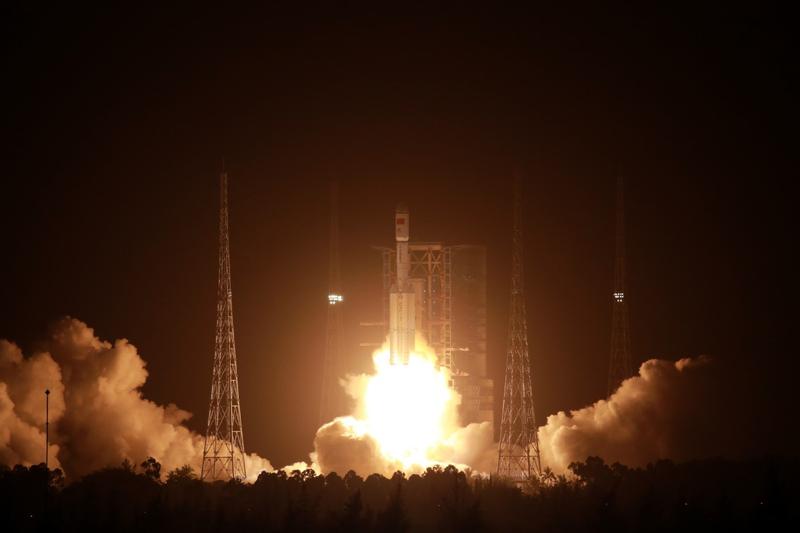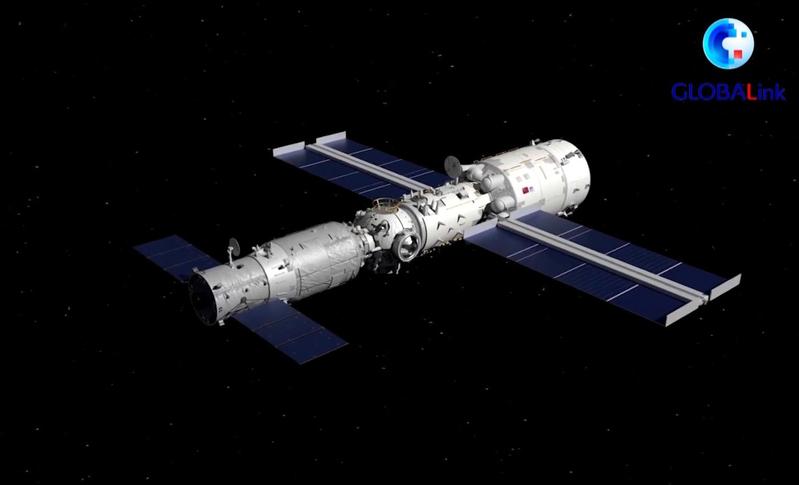 A Long March 7 rocket, carrying the Tianzhou 2 cargo spacecraft, blasts off from the Wenchang Space Launch Center in Hainan province, on May 29, 2021. (TU HAICHAO / FOR CHINA DAILY)
A Long March 7 rocket, carrying the Tianzhou 2 cargo spacecraft, blasts off from the Wenchang Space Launch Center in Hainan province, on May 29, 2021. (TU HAICHAO / FOR CHINA DAILY)
Tianzhou 2, a cargo spacecraft launched on Saturday evening, docked with Tianhe-the recently deployed core module of the country's permanent space station-early on Sunday morning, according to the China Manned Space Agency.
A Long March 7 rocket, carrying Tianzhou 2, blasted off from the Wenchang Space Launch Center on the coast of the southern island province of Hainan at 8:55 pm on Saturday.
After a 10-minute flight atop the 53-meter rocket, the craft entered a low Earth orbit, unfolded its solar panels and began to execute the rapid autonomous rendezvous and docking procedures, which lasted about eight hours, the agency said in a statement.
Tianzhou 2's launch was originally scheduled for the early morning of May 20, but mission commanders decided to postpone it shortly before the predetermined ignition time after a technical problem on the rocket was detected
Tianzhou 2 successfully docked with Tianhe's rear hatch at 5:01 am. Next, it is programmed to conduct autonomous refueling operations and carry out some equipment tests, according to the statement.
When astronauts from the Shenzhou XII spacecraft board Tianhe in the near future, they will gradually move living materials and mission payloads from Tianzhou 2 to the core module.
Tianhe, or Harmony of Heavens, was lifted by a Long March 5B heavy-lift rocket at the Wenchang launch center on April 29. The module, the largest and heaviest spacecraft China has ever built, is the first part of the Chinese space station, named Tiangong, or Heavenly Palace.
ALSO READ: Tiangong space station ready for next stage of construction
Before docking with Tianzhou 2, Tianhe carried out a series of tests to verify its designs for rendezvous and docking maneuvers, astronaut accommodation and experimental equipment.
Hao Chun, director of the manned space agency, said previously that the Shenzhou XII spacecraft, carrying three astronauts, will launch and dock with Tianhe early in June. The crew will stay in the module for three months.
Tianzhou 2's launch was originally scheduled for the early morning of May 20, but mission commanders decided to postpone it shortly before the predetermined ignition time after a technical problem on the rocket was detected.
Over the past 10 days, engineers and technicians from the China Academy of Launch Vehicle Technology, which designed and built the rocket, raced against time to pinpoint and solve the problem and managed to make sure the rocket could be launched on Saturday, according to the academy.
 A composite image shows the Tianzhou 2 cargo spacecraft (left) docking with the Tianhe space station core module. (PHOTO / XINHUA)
A composite image shows the Tianzhou 2 cargo spacecraft (left) docking with the Tianhe space station core module. (PHOTO / XINHUA)
A Tianzhou cargo spaceship has two parts-a cargo cabin and a propulsion section. Such vehicles are 10.6 meters long and 3.35 meters wide. The craft, which has a liftoff weight of 13.5 metric tons, can transport up to 6.9 tons of supplies to the space station, according to Bai Mingsheng, Tianzhou's chief designer at the China Academy of Space Technology.
With a designed life of more than 1 year, Tianzhou 2, the country's second cargo spaceship, carried 6.8 tons of supplies for Tianhe, including 2 tons of propellants, more than 160 packages of living and experiment materials and two roughly 100-kilogram spacesuits for the astronauts to perform extravehicular activities outside the core module.
"Tianzhou 2 features a capability to conduct rapid autonomous docking with the space station. That is very significant for the station's operation because it ensures the timely delivery of time-sensitive items such as biological materials needed in experiments," Bai said. "Furthermore, such capability improves our readiness to respond to possible emergencies, as it can ferry urgently needed supplies to astronauts."
Beside refueling and resupplying tasks, the cargo ship will be used in scientific experiments and technology demonstrations during its linkup with Tianhe, but for most of its time in space, the craft will be dormant to save fuel and energy, Bai Mingsheng, Tianzhou's chief designer at the China Academy of Space Technology, said
Beside refueling and resupplying tasks, the cargo ship will be used in scientific experiments and technology demonstrations during its linkup with Tianhe, but for most of its time in space, the craft will be dormant to save fuel and energy, Bai said.
READ MORE: For technician, docking in space is a life pursuit
The designer noted that when Tianzhou 2 departs from Tianhe, it will carry waste from the module and burn up during atmospheric reentry.
Lei Jianyu, a chief structural engineer of Tianzhou 2, said it is the world's best cargo ship when it comes to carrying capacity-before it, no cargo vehicle could transport as much as 6.9 tons of materials to space.
He said there are 18 cubic meters inside the vehicle for cargo and the shelves' shapes and arrangements were carefully calculated to make it easy for astronauts to move among them to get desired items.
Hao, from the manned space agency, said the Tianzhou 3 cargo ship will be launched in September to dock with Tianhe. In October, another three-astronaut team will fly to the core module on Shenzhou XIII to stay there for six months.
Two large space labs will be launched next year to connect with the module, and 2022 will also see two manned missions and two robotic cargo flights to further the construction of the Tiangong space station, which is scheduled to be completed around the end of next year.
Tiangong, China's most adventurous space endeavor, will consist of three main components-a core module attached to two space labs-with a combined weight of nearly 70 tons. The entire station is set to operate for about 15 years, mission planners have said.
READ MORE: Space station modules ready for missions
Tianzhou 2's predecessor, Tianzhou 1, was China's biggest spacecraft when it entered service and was launched at the Wenchang launch center in April 2017.
It carried out several docking and in-orbit refueling maneuvers with a Chinese space laboratory in a low Earth orbit from April to September that year, making China the third nation with in-orbit refueling capability, after the former Soviet Union and the United States.
The world's first operational cargo spacecraft, Progress 7K-TG, was developed and launched by the Soviet Union in 1978. This type of transport vehicle conducted 43 cargo flights before being retired in 1990.
More than 200 cargo vehicles have been sent to deliver supplies to space stations. Currently, four models are in service-China's Tianzhou, Russia's Progress-MS and the US' Cargo Dragon and Cygnus.


